Predicting the Productivity of Municipality Workers: A Comparison of Six Machine Learning Algorithms
Abstract
1. Introduction
1.1. Gaps Covered in the Present Study
1.2. The Main Aim of the Study
- Evaluating the difference between targeted productivity and the actual productivity of all the 12 different departments in the municipality;
- To evaluate the degree of incentive provided by the department to each of their workers according to the amount of productivity generated by the worker during the year.
2. Theoretical Background
2.1. Employee Productivity
2.2. Machine Learning Prediction on Productivity
3. Research Methodology
3.1. Data Sampling
3.2. Dataset Description
3.3. Identification of Algorithms through Lazy Predict Python Library
3.4. Preprocess of Data
3.5. Graphs and Statistics
3.5.1. Targeted and Actual Productivity
3.5.2. Evaluation of Incentive Based on Productivity
3.5.3. Correlation Matrix
3.6. Development of the Model
| Algorithm 1. Algorithm function of Gradient Boosting. |
| Input: a differentiable loss function with several iterations M. |
| 1. Begin the model with a constant value: |
| 2. For m ranging from 1 to M: |
| Calculate the so-called pseudo-residuals: |
| • Fit a base learner (or weak learner, such as a tree) that is closed under scaling to pseudo-residuals, i.e., train it with the training set. (Johansson n.d.) |
| • Determine the multiplier by solving the one-dimensional optimization problem: |
| • Revise the model: |
| 3. Productivity |
- (1)
- Gather and interact with the information, such as by adjusting the info/yield factors and gathering the preparation/testing datasets;
- (2)
- Train the relapse model with the GBRT using the training dataset;
- (3)
- Verify the prepared model with the testing dataset;
- (4)
- Apply the model to real-world problems.
| Algorithm 2. Algorithm function of Ada Boost. |
| Algorithm |
| 1. Consider a training set (), initialize the weights to and initialize the number of weak learners h |
| 2. For g in 1 to G |
| i. Compute the error of each learner by using the square loss function
|
| ii. Select the weak learner which minimizes the error. |
| iii. Add it to the tree-building algorithm
|
| where A is the learning rate. |
| iv. Update the weights . |
| 3. is the final prediction. Freund and Schapire (1997)
|
| where is the overall model, is the overall obtained in the previous round, is the prediction result of the i-th tree, and is the newly added tree Freund and Schapire (1997) (refer to Figure 8). |
4. Results
Evaluation of the Model
- n = number of data points
- = observed values
- = predicted values
- = Coefficient of determination;
- RSS = Sum of squares of residuals;
- TSS = Total sum of the squares.
5. Discussion
6. Conclusions
7. Future Implications and Limitations of the Study
Author Contributions
Funding
Informed Consent Statement
Data Availability Statement
Conflicts of Interest
References
- Ali, Bayad Jamal, and Govand Anwar. 2021. An empirical study of employees’ motivation and its influence job satisfaction. International Journal of Engineering, Business and Management 5: 21–30. [Google Scholar]
- Anakpo, Godfred, Zanele Nqwayibana, and Syden Mishi. 2023. The Impact of Work-from-Home on Employee Performance and Productivity: A Systematic Review. Sustainability 15: 4529. [Google Scholar] [CrossRef]
- Balla, Imanuel, Sri Rahayu, and Jajang Jaya Purnama. 2021. Garment employee productivity prediction using random forest. Jurnal Techno Nusa Mandiri 18: 49–54. [Google Scholar] [CrossRef]
- Banu, Sohara, Nipun Agarwal, Akhil Singh, Sobiya Shaik, and P. Sai Nikitha. 2020. Machinelearningalgorithm to predict and improve efficiency of employee performance in organizations. International Journal of Advanced Research in Computer Science 11: 6. [Google Scholar]
- Bari, M. Ehteshamul, and Pritam Dey. 2022. Local Governance in India During a Pandemic: A Case for Granting Agency to Municipal Governments. In International Handbook of Disaster Research. Singapore: Springer Nature, pp. 1–19. [Google Scholar]
- Bonaiuto, Flavia, Stefania Fantinelli, Alessandro Milani, Michela Cortini, Marco Cristian Vitiello, and Marino Bonaiuto. 2022. Perceived organizational support and work engagement: The role of psychosocial variables. Journal of Workplace Learning 34: 418–36. [Google Scholar]
- Boyacı, Tamer, Caner Canyakmaz, and de Francis Véricourt. 2023. Human and machine: The impact of machine input on decision making under cognitive limitations. Management Science, ahead of print. [Google Scholar]
- Brownlee, Jason. 2021. Histogram-Based Gradient Boosting Ensembles in Python. Available online: machinelearningmastery.com (accessed on 27 April 2021).
- Chau, Nancy, Ravi Kanbur, and Vidhya Soundararajan. 2022. Employer Power and Employment in Developing Countries. The SC Johnson College of Business Applied Economics and Policy Working Paper Series, (2022-07); Rochester: SSRN. [Google Scholar]
- Chen, Tianqi, and Carlos Guestrin. 2016. Xgboost: A scalable tree boosting system. Paper presented at the 22nd ACM SIGKDD International Conference on Knowledge Discovery and Data Mining, San Francisco, CA, USA, August 13–17; pp. 785–94. [Google Scholar]
- Clement, Bernadetha, and Paul Martin Gwaltu. 2023. Assessing Factors influencing Employees Work Productivity in Tanzania’s Local Government. International Journal of Engineering, Business and Management 7: 12–19. [Google Scholar] [CrossRef]
- Elaho, Omoruyi Bernard, and Amuen Samson Odion. 2022. The Impact of Work Environment on Employee Productivity: A Case Study of Business Centers in University of Benin Complex. Amity Journal of Management Research 5: 782–97. [Google Scholar]
- Feng, De Cheng, and Bo Fu. 2020. Shear strength of internal reinforced concrete beam-column joints: Intelligent modeling approach and sensitivity analysis. Advances in Civil Engineering 2020: 1–19. [Google Scholar] [CrossRef]
- Fleisher, Belton M., Yifan Hu, Hu Li, and Seonghoon Kim. 2011. Economic transition, higher education, and worker productivity in China. Journal of Development Economics 94: 86–94. [Google Scholar] [CrossRef]
- Freund, Yoav, and Robert E. Schapire. 1997. A decision-theoretic generalization of on-line learning and an application to boosting. Journal of Computer And system Sciences 55: 119–39. [Google Scholar] [CrossRef]
- Goumopoulos, Christos, and Nektaria Potha. 2023. Mental fatigue detection using a wearable commodity device and machine learning. Journal of Ambient Intelligence and Humanized Computing 14: 10103–21. [Google Scholar] [CrossRef]
- Graw, J. H., W. T. Wood, and B. J. Phrampus. 2021. Predicting global marine sediment density using the random forest regressor machine learning algorithm. Journal of Geophysical Research: Solid Earth 126: e2020JB020135. [Google Scholar]
- Harter, James K., Frank L. Schmidt, Sangeeta Agrawal, Anthony Blue, Stephanie K. Plowman, Patrick Josh, and Jim Asplund. 2013. The Relationship between Engagement at Work and Organizational Outcomes. Washington, DC: Gallup Poll Consulting University Press. [Google Scholar]
- Hassani, Ibtissam E., Choumicha E. I. Mazgualdi, and Tawfik Masrour. 2019. Artificial intelligence and machine learning to predict and improve efficiency in manufacturing industry. arXiv arXiv:1901.02256. [Google Scholar]
- Hayduk, Leslie A. 2006. Blocked-error-R 2: A conceptually improved definition of the proportion of explained variance in models containing loops or correlated residuals. Quality and Quantity 40: 629–49. [Google Scholar] [CrossRef]
- Hodson, Timothy O. 2022. Root-mean-square error (RMSE) or mean absolute error (MAE): When to use them or not. Geoscientific Model Development 15: 5481–87. [Google Scholar]
- Hong, Liang, and Siti Rohaida Mohamed Zainal. 2022. The Mediating Role of Organizational Culture (OC) on the Relationship between Organizational Citizenship Behavior (OCB) and Innovative Work Behavior (IWB) to Employee Performance (EP) in Education Sector of Malaysia. Global Business & Management Research 14: 1022–43. [Google Scholar]
- Hui, Gang, Zhangxin Chen, Youjing Wang, Dongmei Zhang, and Fei Gu. 2023. An integrated machine learning-based approach to identifying controlling factors of unconventional shale productivity. Energy 266: 126512. [Google Scholar]
- Ibrahim, Muna, and Esther Cuadrado. 2023. The Impact of Corporate Culture on Employee Performance: A Scoping Review. Migration Letters 20: 1267–84. [Google Scholar]
- Ismajli, Naim, Jusuf Zekiri, Ermira Qosja, and Ibrahim Krasniqi. 2015. The importance of motivation factors on employee performance in Kosovo municipalities. Journal of Political Sciences & Public Affairs 3: 2–6. [Google Scholar]
- Jin, Yue, Makram Bouzid, Armen Aghasaryan, and Ricardo Rocha. 2023. Community Selection for Multivariate KPI Predictions in a 2-Tier System. In NOMS 2023–2023 IEEE/IFIP Network Operations and Management Symposium. Piscataway: IEEE, pp. 1–5. [Google Scholar]
- Johansson, Richard. n.d. An Intuitive Explanation of Gradient Boosting. Available online: https://www.cse.chalmers.se/~richajo/dit866/files/gb_explainer.pdf (accessed on 1 January 2024).
- Juszczyk, Michal. 2023. Construction Work Efficiency Analysis—Application of Probabilistic Approach and Machine Learning for Formworks Assembly. Applied Sciences 13: 5780. [Google Scholar] [CrossRef]
- Karthik, Dasari, and C. B. Kameswara Rao. 2022. Identifying the significant factors affecting the masonry labour productivity in building construction projects in India. International Journal of Construction Management 22: 464–72. [Google Scholar] [CrossRef]
- Kazakov, Oleg D., Natalya A. Kulagina, and Natalya Y. Azarenko. 2020. Machine Learning Methods in Municipal Formation. In Growth Poles of the Global Economy: Emergence, Changes and Future Perspectives. Cham: Springer, pp. 339–46. [Google Scholar]
- Kim, Sungil, Kwang Hyun Kim, and Jung Tek Lim. 2023. Synergistic enhancement of productivity prediction using machine learning and integrated data from six shale basins of the USA. Geoenergy Science and Engineering 229: 212068. [Google Scholar]
- Kokenova, A. T., T. N. Mashirova, K. K. Mamutova, R. A. Kaukeshova, and B. N. Sabenova. 2020. Adaptation of models of foreign countries in the management of municipal development and its resource provision. Научный журнал «Дoклады НАН РК» 3: 175–84. [Google Scholar] [CrossRef]
- Kuhn, Max, and Kjell Johnson. 2013. Applied Predictive Modeling. Berlin and Heidelberg: Springer, vol. 26, pp. 203–6. [Google Scholar]
- Li, Daihong, Zhili Tang, Qian Kang, Xiaoyu Zhang, and Youhua Li. 2023. Machine Learning-Based Method for Predicting Compressive Strength of Concrete. Processes 11: 390. [Google Scholar] [CrossRef]
- LoPalo, Melissa. 2023. Temperature, Worker Productivity, and Adaptation: Evidence from Survey Data Production. American Economic Journal: Applied Economics 15: 192–229. [Google Scholar] [CrossRef]
- Madumo, Onkgopotse Senatla. 2012. Contexualising leadership challenges in municipalities: A developmental impression. African Journal of Public Affairs 5: 82–92. [Google Scholar]
- Mahoto, Naeem, Rabia Iftikhar, Asadullah Shaikh, Yousef Asiri, Abdullah Alghamdi, and Khairan Rajab. 2021. An Intelligent Business Model for Product Price Prediction Using Machine Learning Approach. Intelligent Automation & Soft Computing 30: 147–59. [Google Scholar]
- Mallick, Arpit, Subhra Dhara, and Sushant Rath. 2021. Application of machine learning algorithms for prediction of sinter machine productivity. Machine Learning with Applications 6: 100186. [Google Scholar] [CrossRef]
- Mandot, Pushkar. 2017. What Is LightGBM, How to Implement It? How to Fine Tune the Parameters? San Francisco: Medium. [Google Scholar]
- Manu, Christian Addai. 2015. The Effects of Work Environment on Employees Productivity in Government Organizations. A Case Study of Obuasi Municipal Assembly. Ph.D. dissertation, Kwame Nkrumah University of Science and Technology, Kumasi, Ghana. [Google Scholar]
- Massoudi, Aram Hanna, and Samir Salah Aldin Hamdi. 2017. The Consequence of work environment on Employees Productivity. IOSR Journal of Business and Management 19: 35–42. [Google Scholar]
- Melibaev, Makhmudjon, Sadiqjon Negmutullaev, Makhliyo Jumaeva, and Saydullahon Akbarov. 2023. Point estimation of the true value and mean square deviation of the measurement. Science and Innovation 2: 179–86. [Google Scholar]
- Multan, Ewa, Marzena Wójcik-Augustyniak, Bartosz Sobotka, and Jakub Bis. 2023. Application of Performance and Efficiency Indicators in Measuring the Level of Success of Public Universities in Poland. Sustainability 15: 13673. [Google Scholar] [CrossRef]
- Nadeem. 2021. Introduction to XGBoost Algorithm. San Francisco: Medium. [Google Scholar]
- Nkambule, Bongani Innocent. 2023. Organisational Learning and Knowledge Sharing Culture in Township Schools: An Exploration of Effective and Ineffective Practices. Jurnal Penelitian dan Pengkajian Ilmu Pendidikan: E-Saintika 7: 60–74. [Google Scholar] [CrossRef]
- Obiedat, Ruba, and Sara Amjad Toubasi. 2022. A Combined Approach for Predicting Employees’ Productivity based on Ensemble Machine Learning Methods. Informatica 46: 49–58. [Google Scholar]
- Okpara, Chinedu R., Victor E. Idigo, and Chukwunenye S. Okafor. 2023. Comparative analysis of the features of a 5G network production dataset: The machine learning approach. European Journal of Engineering and Technology Research 8: 52–57. [Google Scholar]
- Pampouktsi, Panagiota, Spyridon Avdimiotis, Manolis Maragoudakis, Markos Avlonitis, Nikita Samantha, Praveen Hoogar, George Mugambage Ruhago, and Wcyliffe Rono. 2023. Techniques of Applied Machine Learning Being Utilized for the Purpose of Selecting and Placing Human Resources within the Public Sector. Journal of Information System Exploration and Research 1: 1–16. [Google Scholar] [CrossRef]
- Park, Soyoung, Solyong Jung, Jaegul Lee, and Jin Hur. 2023. A Short-Term Forecasting of Wind Power Outputs Based on Gradient Boosting Regression Tree Algorithms. Energies 16: 1132. [Google Scholar] [CrossRef]
- Patil, Sangram, Aum Patil, and Vikas M. Phalle. 2018. Life prediction of bearing by using adaboost regressor. Paper presented at the TRIBOINDIA-2018 an International Conference on Tribology, Mumbai, India, December 15. [Google Scholar]
- Piepho, Hans Peter. 2023. An adjusted coefficient of determination (R2) for generalized linear mixed models in one go. Biometrical Journal 65: 2200290. [Google Scholar] [CrossRef]
- Rahman, Md. Mostafizur, and Sumiya Akter Nisher. 2023. Predicting Average Localization Error of Underwater Wireless Sensors via Decision Tree Regression and Gradient Boosted Regression. Paper presented at the International Conference on Information and Communication Technology for Development: ICICTD 2022, Khulna, Bangladesh, July 29–30; Singapore: Springer Nature, pp. 29–41. [Google Scholar]
- Razali, Mohd Norhisham, Norizuandi Ibrahim, Rozita Hanapi, Norfarahzila Mohd Zamri, and Syaifulnizam Abdul Manaf. 2023. Exploring Employee Working Productivity: Initial Insights from Machine Learning Predictive Analytics and Visualization. Journal of Computing Research and Innovation 8: 235–45. [Google Scholar]
- Santhose, Samuel Sam, and Baby Anisha. 2023. Psychological improvement in Employee Productivity by Maintaining Attendance System using Machine Learning Behavior. Journal of Community Psychology 51: 270–83. [Google Scholar] [CrossRef]
- Sarker, Iqbal H. 2022. Machine learning for intelligent data analysis and automation in cybersecurity: Current and future prospects. Annals of Data Science 10: 1473–98. [Google Scholar] [CrossRef]
- Sauermann, Jan. 2023. Performance Measures and Worker Productivity. Bonn: IZA World of Labor. [Google Scholar]
- Sheehan, Maura, and Thomas Garavan. 2022. High-performance work practices and labour productivity: A six-wave longitudinal study of UK manufacturing and service SMEs. The InTernaTIonal Journal of Human Resource Management 33: 3353–86. [Google Scholar] [CrossRef]
- Shwartz-Ziv, Ravid, and Amitai Armon. 2022. Tabular data: Deep learning is not all you need. Information Fusion 81: 84–90. [Google Scholar] [CrossRef]
- Song, Laiming, Chunqiu Wang, Chuan Lu, Shuo Yang, Chaodong Tan, and Xiongying Zhang. 2023. Machine Learning Model of Oilfield Productivity Prediction and Performance Evaluation. Journal of Physics: Conference Series 2468: 012084. [Google Scholar]
- Sorostinean, Radu, Arpad Gellert, and Bogdan Constantin Pirvu. 2021. Assembly Assistance System with Decision Trees and Ensemble Learning. Sensors 21: 3580. [Google Scholar] [CrossRef]
- Sulistyaningsih, Elli. 2023. Improving Human Resources Technology Innovation as a Business Growth Driver in the Society 5.0 Era. ADI Journal on Recent Innovation 4: 149–59. [Google Scholar] [CrossRef]
- Chai, Tianfeng, and R. Roland Draxler. 2014. Root mean square error (RMSE) or mean absolute error (MAE). Geoscientific Model Development Discussions 7: 1525–34. [Google Scholar] [CrossRef]
- Wardhani, Rulyanti Susi, Kamal Kant, Anusha Sreeram, Monica Gupta, Erwandy Erwandy, and Pranjal Kumar Bora. 2022. Impact of Machine Learning on the Productivity of Employees in Workplace. Paper presented at the 2022 4th International Conference on Inventive Research in Computing Applications (ICIRCA), Coimbatore, India, September 21; New York: IEEE, pp. 930–34. [Google Scholar]
- Zamani Joharestani, Mehdi, Chunxiang Cao, Xiliang Ni, Barjeece Bashir, and Somayeh Talebiesfandarani. 2019. PM2.5 prediction based on random forest, XGBoost, and deep learning using multisource remote sensing data. Atmosphere 10: 373. [Google Scholar] [CrossRef]
- Zebua, Selamat, and Mochamad Heru Riza Chakim. 2023. Effect of Human Resources Quality, Performance Evaluation, and Incentives on Employee Productivity at Raharja High School. APTISI Transactions on Management (ATM) 7: 1–7. [Google Scholar]
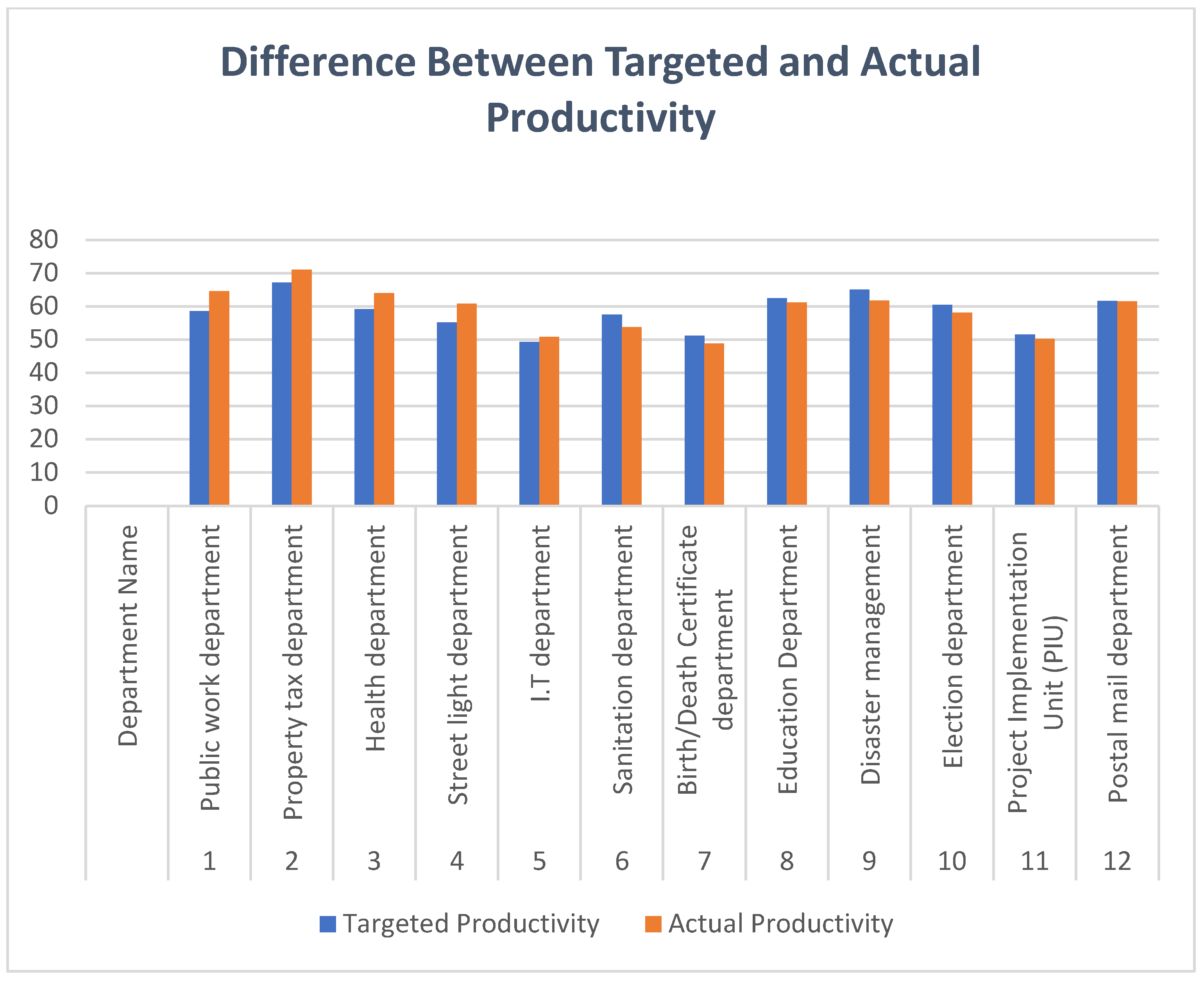
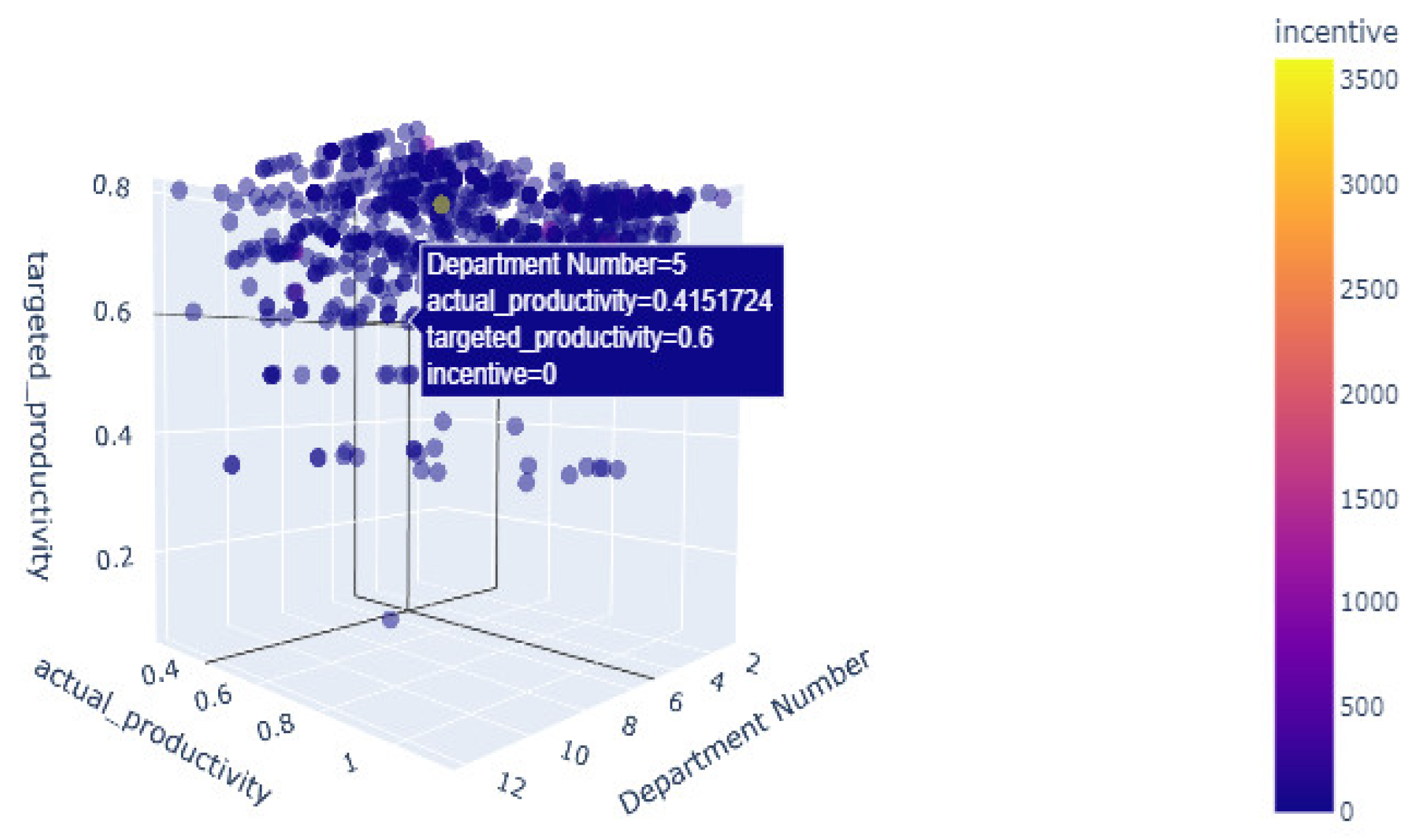

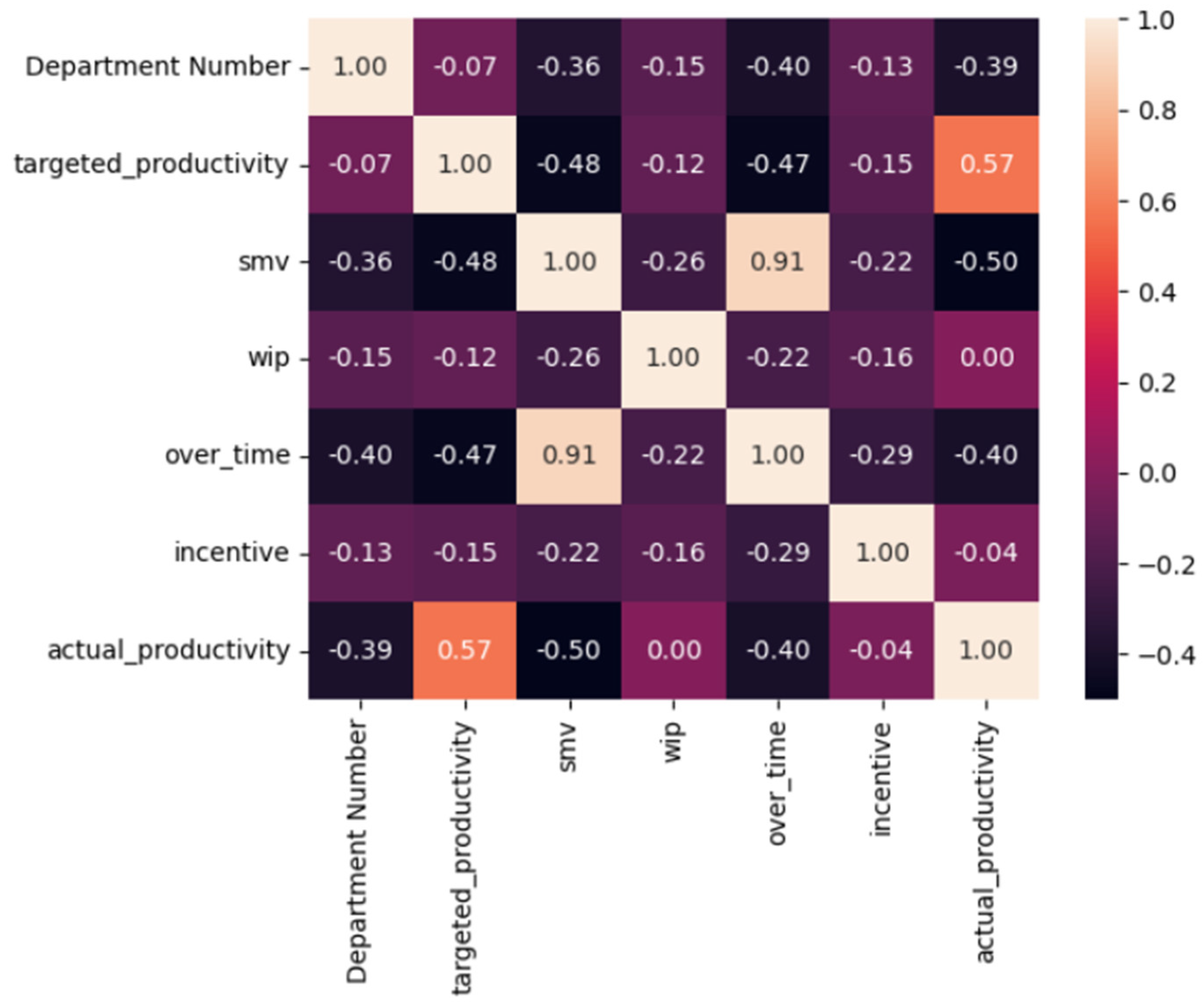
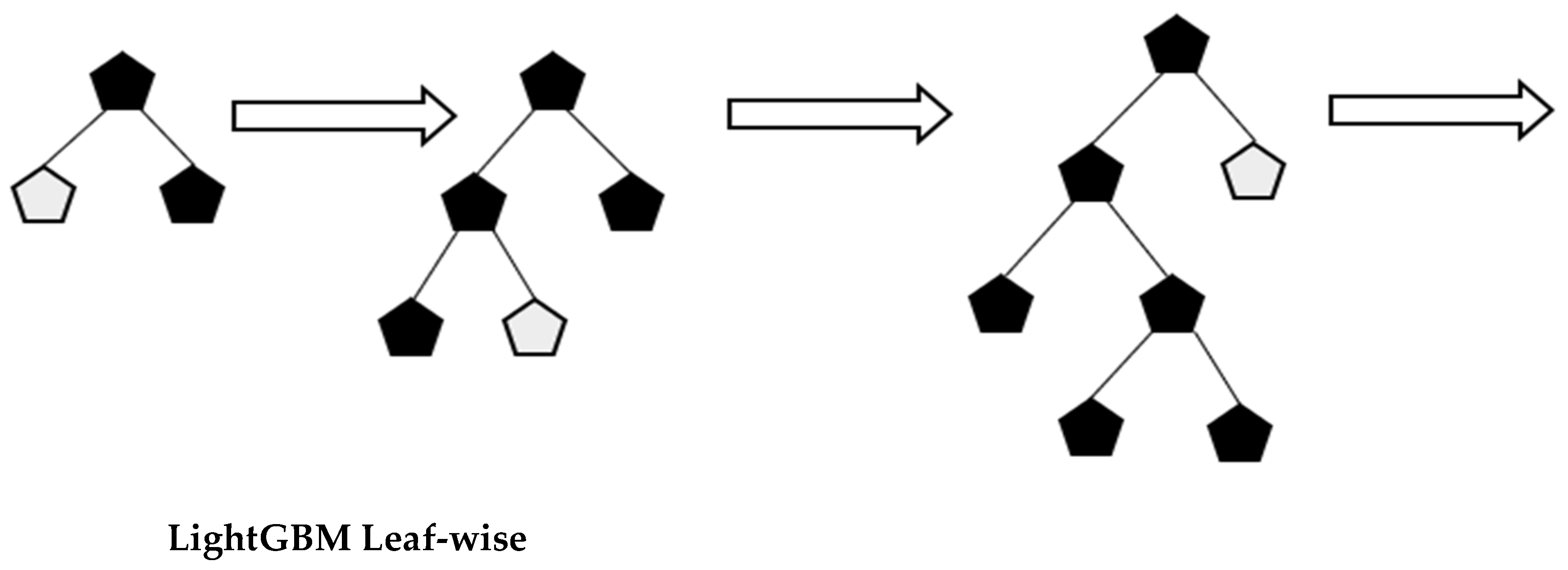
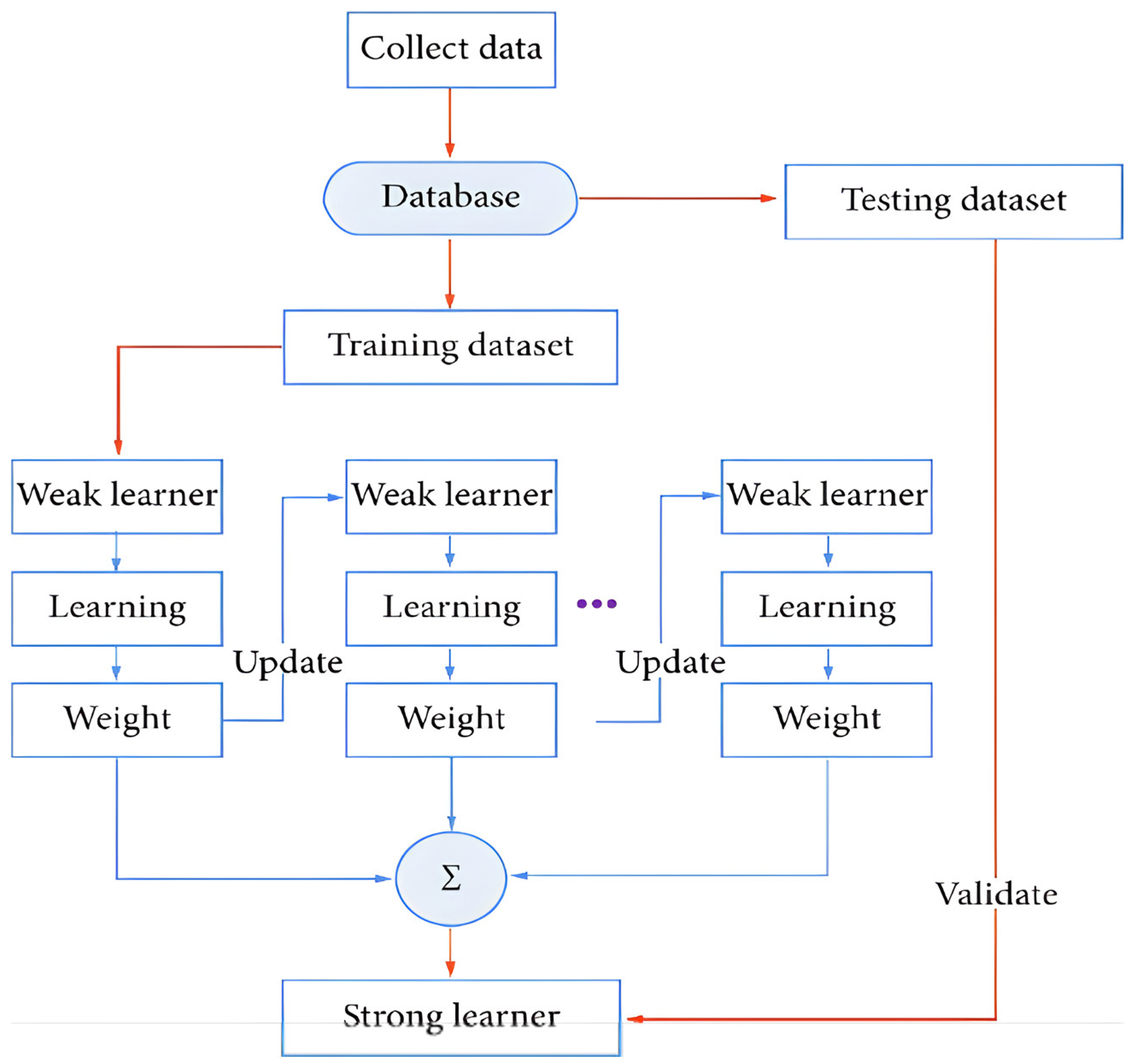
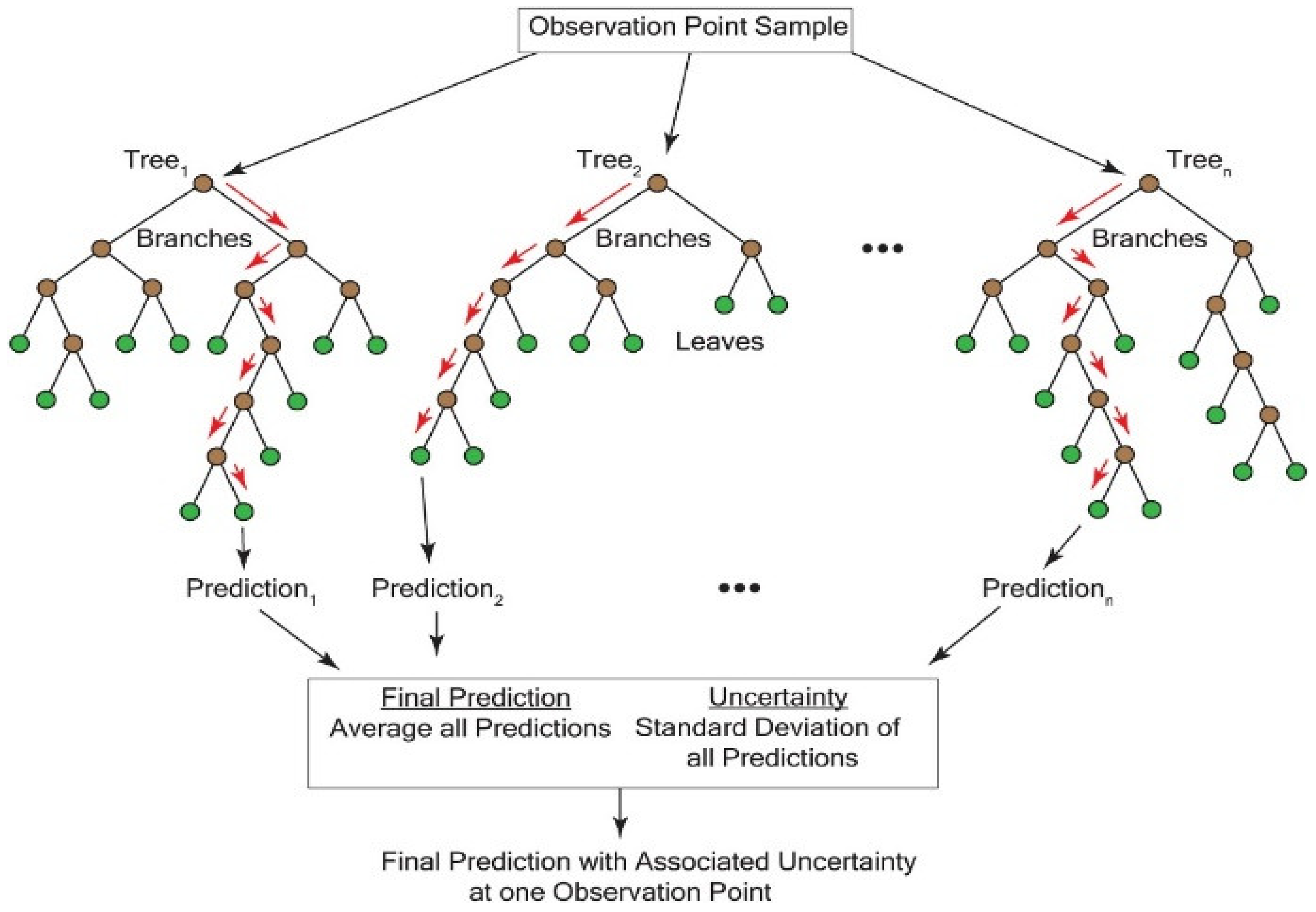

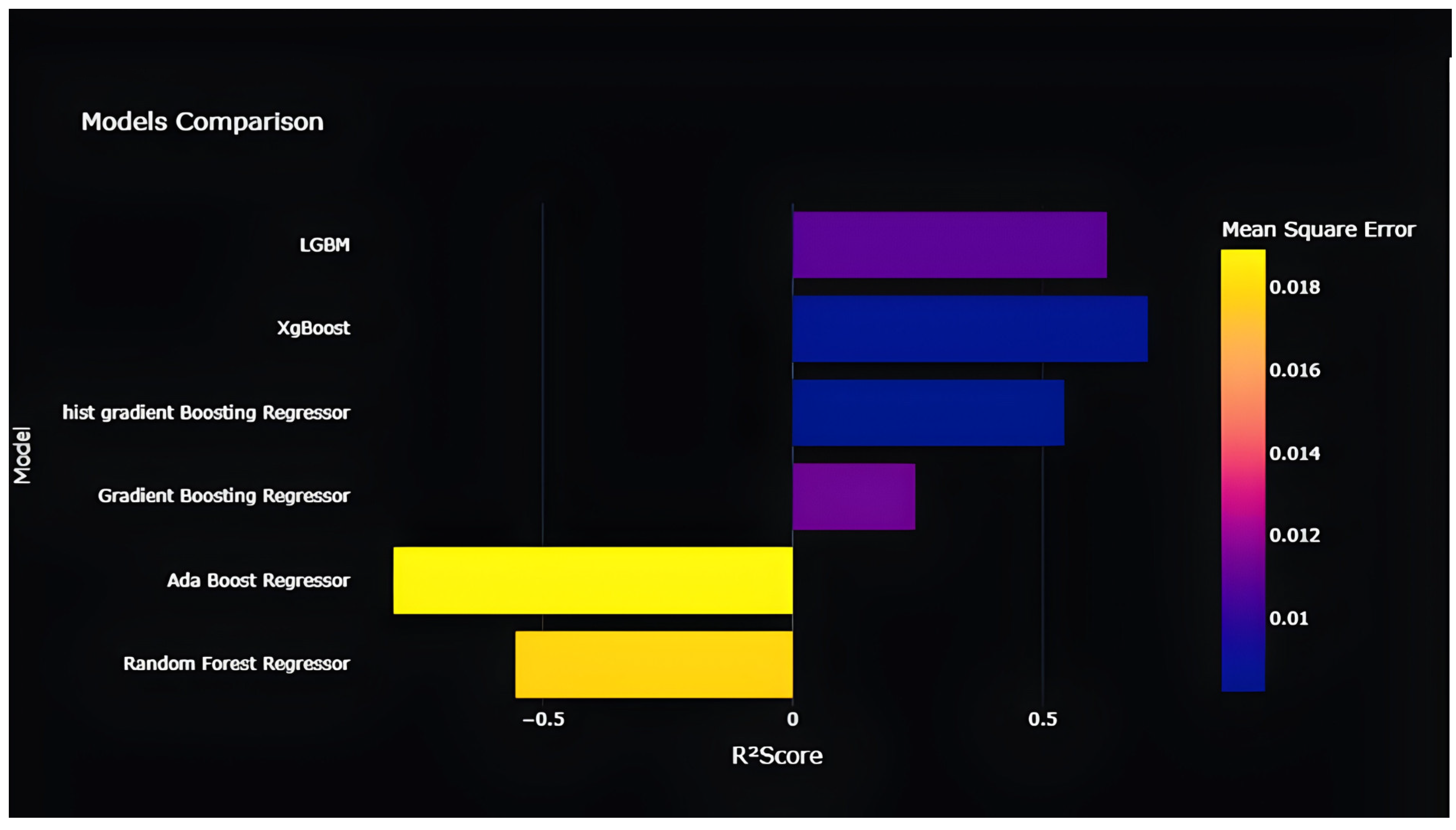
| No. of Steps | Description of Research Methodology |
|---|---|
| 1 | A total population of 1098 was extracted from the 4 different municipalities. |
| 2 | Six algorithms were identified through lazy prediction and applied to the data set. |
| 3 | The data were studied thoroughly by the authors for further pre-processing through Jupyter Notebook in Python language. In the preprocessing part, the data are organized (numbering each department, segregating the workers department-wise, handling missing values). |
| 4 | Further correlation analysis was performed to find out the correlation between the variables and to clearly understand the data in and out. |
| 5 | Fourthly, the data were split up into two parts: training and testing. Training consisted of 879, and testing contained 219. |
| 6 | The model was trained, and correlation analysis was applied to predict the required results. |
| 7 | Lastly, with the help of the results and the evaluation process of the model techniques like MSE and R Squared, a predictive model was developed. |
| S. No. | Attribution | Description |
|---|---|---|
| 1 | Department Number | It ranges from 1–12. |
| 2 | Targeted productivity | Productivity targets are set by the department for each team for each quarter. |
| 3 | SMV | Standard Minute Value is the allocated time for a task. |
| 4 | WIP | Work in progress. Includes the number of unfinished works for each department. |
| 5 | Overtime | Represents the amount of overtime by each team in minutes. |
| 6 | Incentive | Represents the level of financial incentive that enables or motivates a particular course of action. |
| 7 | Actual productivity: | Percentage of actual productivity provided by workers. It varies from 0 to 1. |
| Department No. | Department Name | No. of Workers (Data from Each Dept) |
|---|---|---|
| 1. | Public work department | 90 |
| 2. | Property tax department | 99 |
| 3. | Health department | 88 |
| 4. | Street light department | 94 |
| 5. | IT department | 85 |
| 6. | Sanitation department | 91 |
| 7. | Birth/Death Certificate department | 86 |
| 8. | Education department | 101 |
| 9. | Disaster management | 96 |
| 10. | Election department | 93 |
| 11. | Project Implementation Unit (PIU) CELL | 80 |
| 12. | Postal mail department | 95 |
| S. No. | Model | Adjusted R Squared | R Squared | RMSE | Time Taken |
|---|---|---|---|---|---|
| 1 | Gradient Boosting Regressor | 0.37 | 0.39 | 0.14 | 0.09 |
| 2 | LGBM Regressor | 0.33 | 0.35 | 0.15 | 0.07 |
| 3 | Hist Gradient Boosting Regressor | 0.33 | 0.35 | 0.15 | 0.48 |
| 4 | Random Forest Regressor | 0.2 | 0.22 | 0.16 | 0.31 |
| 5 | Ada-boost Algorithm | 0.17 | 0.2 | 0.16 | 0.05 |
| 6 | Xg-Boost Regressor | 0.11 | 0.14 | 0.17 | 0.1 |
| Model | R Squared | MSE (Mean Squared Error) |
|---|---|---|
| XG Boost | 0.71 | 0.01 |
| LGBM | 0.63 | 0.01 |
| Hist Gradient Boosting Regressor | 0.54 | 0.01 |
| Gradient Boosting Regressor | 0.25 | 0.01 |
| Random Forest Regressor | −0.55 | 0.02 |
| Ada Boost Regressor | −0.80 | 0.02 |
Disclaimer/Publisher’s Note: The statements, opinions and data contained in all publications are solely those of the individual author(s) and contributor(s) and not of MDPI and/or the editor(s). MDPI and/or the editor(s) disclaim responsibility for any injury to people or property resulting from any ideas, methods, instructions or products referred to in the content. |
© 2024 by the authors. Licensee MDPI, Basel, Switzerland. This article is an open access article distributed under the terms and conditions of the Creative Commons Attribution (CC BY) license (https://creativecommons.org/licenses/by/4.0/).
Share and Cite
Bijalwan, P.; Gupta, A.; Mendiratta, A.; Johri, A.; Asif, M. Predicting the Productivity of Municipality Workers: A Comparison of Six Machine Learning Algorithms. Economies 2024, 12, 16. https://doi.org/10.3390/economies12010016
Bijalwan P, Gupta A, Mendiratta A, Johri A, Asif M. Predicting the Productivity of Municipality Workers: A Comparison of Six Machine Learning Algorithms. Economies. 2024; 12(1):16. https://doi.org/10.3390/economies12010016
Chicago/Turabian StyleBijalwan, Priya, Ashulekha Gupta, Anubhav Mendiratta, Amar Johri, and Mohammad Asif. 2024. "Predicting the Productivity of Municipality Workers: A Comparison of Six Machine Learning Algorithms" Economies 12, no. 1: 16. https://doi.org/10.3390/economies12010016
APA StyleBijalwan, P., Gupta, A., Mendiratta, A., Johri, A., & Asif, M. (2024). Predicting the Productivity of Municipality Workers: A Comparison of Six Machine Learning Algorithms. Economies, 12(1), 16. https://doi.org/10.3390/economies12010016







